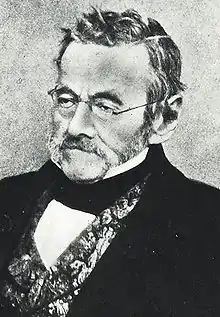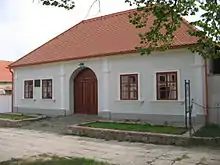Charles Sealsfield
Charles Sealsfield was the pseudonym of Austrian-American journalist Carl (or Karl) Anton Postl (3 March 1793 – 26 May 1864), an advocate for a German democracy. He lived in the United States from 1822 to 1826, and then again in 1828/1829. During a final stay from 1853 to 1858 he became a US citizen. Sealsfield is best known for his German-language Romantic novels with American backgrounds, and also wrote travelogues. He returned to Europe about 1829, living in Paris and London before settling in Switzerland in 1832, where he resided for most of the rest of his life.

Biography

Carl Anton Postl was born at Popice u Znojma (Poppitz) near Znojmo in Moravia, then part of the Austria-Hungary Empire. His schooling completed, he entered the Knights of the Cross with the Red Star in Prague, where he became a priest. In the autumn of 1822, apparently fleeing the repressive government of Prince Klemens von Metternich, he fled to the United States, where he assumed the name of Charles Sealsfield.
In 1826 he returned to Germany and published a book on America (Die Vereinigten Staaten von Nordamerika). Next he published an outspoken criticism of Austria, first in German, then adapted by Postl into English (Austria as it is, or, sketches of continental courts, by an eye-witness, 1828.) It was published anonymously in London; this book offended the Austrian authorities. The author was a wanted man in that country, but his identity remained unknown.
Meanwhile, Postl had returned to the United States, where he published his first novel, also in English, Tokeah, or the White Rose (1828; translated in German by Gustav Höcker). He became a journalist, first in New York City, where in 1829 he edited the Courier des États Unis.[1] He traveled back to Europe, living first in Paris and then in London, making a living by his journalism and writing accounts of United States life as a correspondent for various journals.
In 1832 Postl settled in Switzerland. In 1860 he purchased a small estate in Solothurn. Here he died in May 1864. His will first revealed the fact that he was the former monk Postl.
He is best known as a German-language novelist. His Tokeah appeared in German under the title Der Legitime und die Republikaner (1838), and was followed by Der Virey und die Aristokraten oder Mexiko im Jahre 1812 (1835), Lebensbilder aus beiden Hemisphären (1835–1837), Sturm-, Land- und Seebilder (1838), Das Kajütenbuch, oder Nationale Charakteristiken (1842). Sealsfield occupies an important position in the development of the German historical novel at a period when the influence of the English author, Sir Walter Scott, was beginning to wane. Postl endeavoured to widen the scope of historical fiction, to describe great national and political movements, without forfeiting the sympathy of his readers for the individual characters of the story.
In 1844, Theodor Mundt declared Sealsfield (whose name he had misread as "Seatsfield") the greatest American author. The Boston Daily Advertiser and other newspapers commenced a search for the true identity of "Seatsfield," but many believed the whole story to be a hoax. The Knickerbocker ran an elaborate satire on the affair in its June 1844 issue.
Sealsfield's Gesammelte Werke (Collected Works) appeared in 18 vols. (1843–1846). A new edition of his complete works in German and English (Sämtliche Werke), chiefly in photographic facsimile, though with new introductions and editorial apparatus) was edited by Sealsfield scholar Karl J. R. Arndt and published by Olms beginning in 1972.
The Zentralbibliothek Solothurn has a large collection of editions and manuscripts.
Works
- The Americans as They Are (1828)
- Transatlantische Reiseskizzen und Christophorus Bärenhäuter. Erstes Bändchen. (1834)
- Transatlantische Reiseskizzen und Christophorus Bärenhäuter. Zweites Bändchen. (1834)
Notes
- Rines, George Edwin, ed. (1920). . Encyclopedia Americana.
References
- Arndt, Karl J. R. (October 1965), "Charles Sealsfield, 'The Greatest American Author" (PDF), Proceedings of the American Antiquarian Society, 74(2): 248–259
- "Editor's Table", The Knickerbocker, or New York Monthly Magazine, June 1844
- Attribution
 This article incorporates text from a publication now in the public domain: Chisholm, Hugh, ed. (1911). "Sealsfield, Charles". Encyclopædia Britannica. 24 (11th ed.). Cambridge University Press. p. 543. This work in turn cites:
This article incorporates text from a publication now in the public domain: Chisholm, Hugh, ed. (1911). "Sealsfield, Charles". Encyclopædia Britannica. 24 (11th ed.). Cambridge University Press. p. 543. This work in turn cites:
- Kertbény, Erinnerungen an Sealsfield (Memories of Sealsfield; 1864)
- L. Schmolle, Charles Sealsfield (1875)
- L. Hamburger, Sealsfield-Postl, bisher unveröffentlichte Briefe (Sealsfield-Postl, until now unpublished letters; 1879)
- A. B. Faust, Charles Sealsfield, der Dichter beider Hemisphären (1896)
Further reading
- Nanette M Ashby, Charles Sealsfield: The greatest American author: a study of literary piracy and promotion in the 19th century, 1980.
External links
| Wikimedia Commons has media related to Charles Sealsfield. |
- Works by Charles Sealsfield at Project Gutenberg
- Works by Charles Sealsfield at Faded Page (Canada)
- Works by or about Charles Sealsfield at Internet Archive
- Biography from the Handbook of Texas Online
- The cabin book; or, sketches of life in Texas by Charles Sealsfield, published 1844, hosted by the Portal to Texas History.
- Writing in a Different Language: The Example of Charles Sealsfield by Donald G. Daviau
